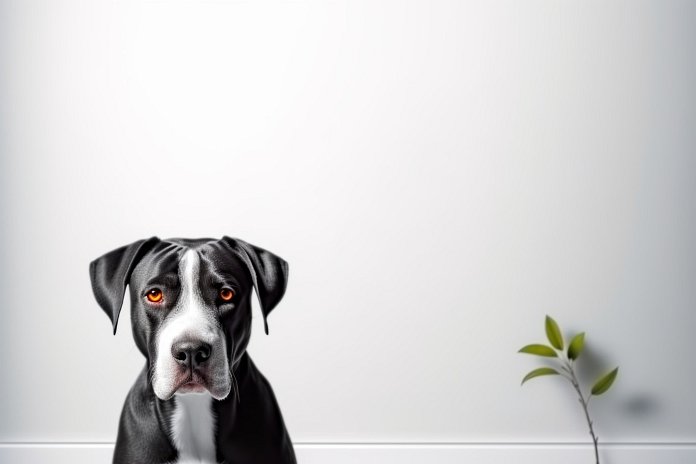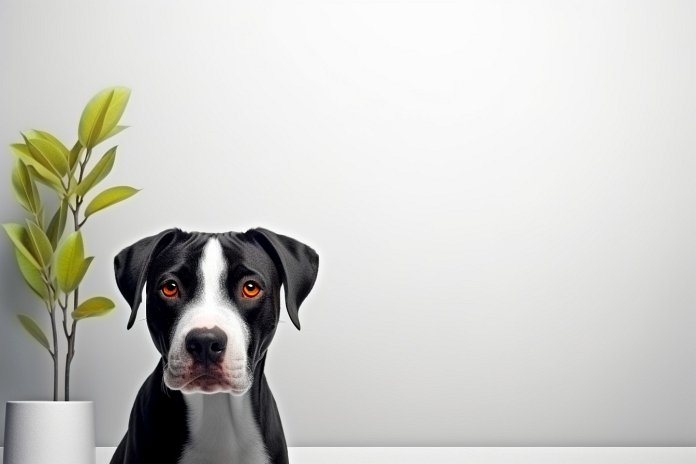
The Amstiff is a crossbreed between the American Staffordshire Terrier and the Mastiff. Another term used for a Mastiff crossed with a Bulldog genus dog is “Bandoggie”. When it comes to grooming, this hybrid breed has minimal requirements. These large dogs are known for their excellent security capabilities and they need a good amount of physical activity. This can be achieved through jogging or walking them on a leash. It is also important to have a fenced-in yard where they can play and run around. While the Amstiff can adapt to apartment living, it is crucial to provide them with enough exercise to prevent boredom and potential mischief. They are known to be great family pets, but early socialization with children is necessary.
Ahead, we look at Amstiff dog breed, its history, personality, pros and cons of owning an Amstiff, characteristics, and must-know facts. We will also examine how to care for this breed and much more. Prepare for a tail-wagging adventure into the world of Amstiffs!
| Dog Breed | Amstiff |
| Size | Medium |
| Weight | 80-130 lbs (average) |
| Height | 20-30″ (average) |
| Location | United States |
| Ancestry | American Staffordshire Terrier, Mastiff |
| Date of Origin | Unknown |
| Group | Companion, Guard Dog |
| Life Expectancy | 10-12 years |
| Price | $800 – $1000 |
| Family | Canidae |
| Scientific Name | Canis Lupus Familiaris |
📖 Breed History
The Amstiff is a unique breed that combines the American Staffordshire Terrier and the Mastiff. The American Staffordshire Terrier, created in the 19th century, was specifically bred to be a smaller and faster fighting dog compared to the Bulldog. Interestingly, despite its fighting origins, the Staffordshire was intended to be friendly towards people. Experts believe it is a mix of the Manchester Terrier and the Bulldog. The American Staffordshire Terrier is generally a family-friendly companion, smaller than the American Pit Bull Terrier, and makes a good watchdog without being overly aggressive.
On the other hand, the Mastiff has a rich history as a descendent of the molosser, believed to originate in the Asian mountains. Depictions of Mastiffs can be found in ancient Greek and Egyptian artwork. They were used as herding dogs and even played a role in warfare under the rule of Kubla Khan. Unfortunately, Mastiffs have also been used in dog fighting, but their true nature is quite gentle. This makes the Amstiff an excellent choice as a companion, watchdog, and all-around family dog.

🐕 Amstiff Appearance
An Amstiff will likely exhibit traits from both of its parent breeds. The American Staffordshire Terrier can be any of these colors with white markings, as well as red, fawn, white, black, or blue. The Mastiff has a fawn or apricot exterior coat that is short and straight and frequently has black markings. Although some Amstiffs have a Mastiff-like head, most Amstiffs resemble the American Staffordshire Terrier only bigger. The Mastiff has a short, thick undercoat, whereas the American Staffordshire Terrier has a short, straight coat. The two are likely to be combined in your Amstiff.
| 👀 Eye Color | Varies |
| 🐽 Nose Color | N/A |
| 🐕 Coat Color | Ranges |
⚡ Fun Fact: Amstiff dogs are a social breed. They enjoy being around people or other animals. This breed doesn’t tolerate being left alone.
🐶 Traits & Temperament of Amstiff
Although Mastiffs and American Staffordshire Terriers were once employed as fighting dogs, they are now gentle giants. Although they get along well with kids, it is advised that they start socializing early. Mastiffs are wary of strangers and have a reputation for putting themselves between their human family and them if they perceive a threat. Although your puppy may have an American Staffordshire Terrier mentality, it may be necessary to enroll your Amstiff in obedience training because Mastiffs are more obstinate than American Staffordshire Terriers. It takes persistence, firmness, consistency, and loving correction to work with an Amstiff.
🤝 Are Amstiffs Friendly or Aggressive?
Amstiff dogs are generally friendly and get along well with other pets. They are also known to be welcoming towards strangers and are very kid-friendly, enjoying the company of children. While they are average when it comes to their friendliness towards cats, they are not the most dog-friendly breed. Therefore, if you are looking to have multiple dogs in your family or want to participate in dog meetups, the Amstiff may not be the best choice. However, they are considered one of the best breeds for elderly people, making them a great companion for seniors.
This breed is known for being:
- Protective
- Alert
- Courageous
- Intelligent
- Friendly
- Affectionate
- Loyal
- Devoted
- Attentive
- Tenacious
- Cheerful
🐩 Amstiff Care & Maintenance
Grooming an American Staffordshire Terrier should be simple because both the Mastiff and the American Staffordshire Terrier have short, straight coats. It is advised to brush your dog using a rubber dog glove once a week. Mastiffs tend to shed more than American Staffordshire Terriers, so you might need to brush them more frequently than once per week. You must regularly wipe the wrinkles on your Amstiff puppy if it inherits the Mastiff wrinkles to avoid bacterial illnesses. To clean, go between the creases with a moist towel. Keep in mind that leaving the area wet might encourage bacterial development. A minimum of three times per week should be spent brushing your Amstiff’s teeth; however, daily brushing is recommended if you wish to avoid gum disease. Every other week, trim your dog’s nails. As a general guideline, you should trim your dog’s nails when you hear them clicking on the floor.
Amstiff dogs are known for being low shedders, which means they don’t lose a lot of hair. This is a natural part of their hair growth cycle. The amount and frequency of hair loss in Amstiff dogs can vary depending on their overall health and the specific breed they belong to. When it comes to bathing, it is recommended to give Amstiff dogs a bath every 4-6 weeks.
🍖 Food: We recommend few cups daily, costing you about $0.49 – $1.49 daily, or around $30.00 a month.
🐾 Exercise: Amstiff dogs have an average exercise need. This breed is satisfied with short walks every weekday and a long ones on weekends.
This dog breed requires to be walked for roughly few miles per week, which equates to about 15 – 35 minutes of physical activity daily. This consistent moderate exercise regimen will help maintain their physical wellness and significantly contribute to their mental stimulation. Consciously setting aside this time for your furry friend can dramatically enhance their life quality, helping them stay energetic, healthy, and mentally alert.
Did you know: Amstiff dogs have an average energy level, so if you live a semi-active life, this breed can be a good choice for you.
❤️🩹 Amstiff Health & Issues
Some of the major concerns for Amstiff Dog Breed can be:
- Gastric Torsion
- Cardiomyopathy
- Progressive Retinal Atrophy
- Hip Dysplasia
While minor concerns include:
- Entropion
🤧 Important: Is Amstiff hypoallergenic? No.
✨ Bonus: Check out cool, creative, and funny names for Amstiff.
⚡ Amstiff Dog Breed Facts
What makes the Amstiff a great choice for families with young children?
The Amstiff is a great choice for families with young children because they are considered to be gentle giants and are known to be great with children. However, it is important to socialize them from an early age to ensure they are comfortable and well-behaved around kids.
Is the Amstiff breed considered a suitable breed for apartment living?
While the Amstiff can be an apartment dog, they do require a good amount of exercise to prevent boredom and mischief. Walking or jogging with them on a leash or providing a fenced-in yard for playtime would be beneficial.
How much exercise does a Amstiff require compared to other breeds?
The Amstiff requires a moderate amount of exercise compared to other breeds. While they don’t need excessive amounts of physical activity, they do need regular exercise to keep them mentally and physically stimulated.
Is the Amstiff breed known for being good with other pets?
The Amstiff breed can be good with other pets, but proper socialization and introduction are necessary. It is always recommended to supervise interactions between pets, especially when introducing new animals to the household.
What are other low-maintenance dog breeds similar to the Amstiff?
Some low-maintenance dog breeds similar to the Amstiff include the Bullmastiff and the Boxer. These breeds also have moderate exercise needs and are known for being good family dogs.
What are the common health issues that Amstiffs are prone to?
Common health issues that Amstiffs are prone to include hip dysplasia, elbow dysplasia, and gastric torsion (bloat). Regular vet check-ups and a proper diet can help prevent or manage these health issues.
Are Amstiffs known to be easy to train compared to other breeds?
Amstiffs can be stubborn, so training may require patience, firmness, consistency, and loving correction. Enrolling them in obedience classes can be beneficial for both the dog and the owner.
Are Amstiffs more prone to separation anxiety compared to other breeds?
Amstiffs, like many other breeds, can experience separation anxiety if not properly trained and gradually accustomed to being alone. Providing them with mental stimulation, crate training, and gradually increasing the time spent alone can help minimize separation anxiety.
Are there any dog breeds similar to the Amstiff that are suitable for people with allergies?
Some dog breeds similar to the Amstiff that are suitable for people with allergies include the American Hairless Terrier, the Bichon Frise, and the Soft Coated Wheaten Terrier. These breeds have hypoallergenic coats that produce fewer allergens.
What sizes of dogs similar to the Amstiff are best for individuals or families with limited space?
For individuals or families with limited space, smaller-sized dogs similar to the Amstiff, such as the Staffordshire Bull Terrier or the Boxer, may be more suitable. These breeds can still provide the same loving and protective nature in a smaller package.
Is the Amstiff breed known to be good with children with special needs?
The Amstiff breed is known to be good with children, but it is important to consider the specific needs and behaviors of children with special needs. Proper supervision and introduction should be practiced to ensure the safety and well-being of both the child and the dog.
How does the grooming and shedding needs of the Amstiff?
The grooming and shedding needs of the Amstiff are relatively low-maintenance. They have short coats that require regular brushing to remove loose hair and keep their coat healthy. They are moderate shedders compared to other breeds with longer or thicker coats.
We use reliable and publicly available data and resources such as AKC and American Canine Registry to ensure that Amstiff dog breed information is accurate and up to date. If you spot an error, please don’t hesitate to bring it to our attention.